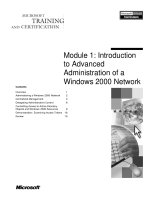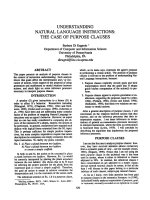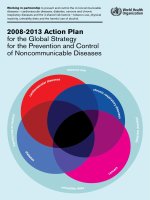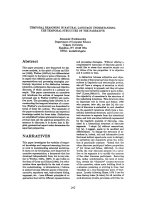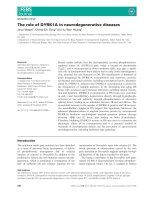ADVANCED UNDERSTANDING OF NEURODEGENERATIVE DISEASES doc
Bạn đang xem bản rút gọn của tài liệu. Xem và tải ngay bản đầy đủ của tài liệu tại đây (23.68 MB, 454 trang )
ADVANCED
UNDERSTANDING OF
NEURODEGENERATIVE
DISEASES
Edited by Raymond Chuen-Chung Chang
Advanced Understanding of Neurodegenerative Diseases
Edited by Raymond Chuen-Chung Chang
Published by InTech
Janeza Trdine 9, 51000 Rijeka, Croatia
Copyright © 2011 InTech
All chapters are Open Access distributed under the Creative Commons Attribution 3.0
license, which permits to copy, distribute, transmit, and adapt the work in any medium,
so long as the original work is properly cited. After this work has been published by
InTech, authors have the right to republish it, in whole or part, in any publication of
which they are the author, and to make other personal use of the work. Any republication,
referencing or personal use of the work must explicitly identify the original source.
As for readers, this license allows users to download, copy and build upon published
chapters even for commercial purposes, as long as the author and publisher are properly
credited, which ensures maximum dissemination and a wider impact of our publications.
Notice
Statements and opinions expressed in the chapters are these of the individual contributors
and not necessarily those of the editors or publisher. No responsibility is accepted for the
accuracy of information contained in the published chapters. The publisher assumes no
responsibility for any damage or injury to persons or property arising out of the use of any
materials, instructions, methods or ideas contained in the book.
Publishing Process Manager Ivana Zec
Technical Editor Teodora Smiljanic
Cover Designer InTech Design Team
Image Copyright Jezper, 2011. Used under license from Shutterstock.com
First published November, 2011
Printed in Croatia
A free online edition of this book is available at www.intechopen.com
Additional hard copies can be obtained from
Advanced Understanding of Neurodegenerative Diseases,
Edited by Raymond Chuen-Chung Chang
p. cm.
ISBN 978-953-307-529-7
Contents
Preface IX
Part 1 Alzheimer's Disease & Dementia 1
Chapter 1 Alzheimer's Disease: Definition,
Molecular and Genetic Factors 3
Eva Babusikova, Andrea Evinova,
Jana Jurecekova, Milos Jesenak and Dusan Dobrota
Chapter 2 Evidence for an Infectious
Etiology in Alzheimer’s Disease 29
Brian Balin, Christine Hammond,
C. Scott Little, Denah Appelt and Susan Hingley
Chapter 3 Amyloid Hypothesis and Alzheimer's Disease 53
Xiaqin Sun and Yan Zhang
Chapter 4 Structure-Toxicity Relationships
of Amyloid Peptide Oligomers 89
Patrick Walsh and Simon Sharpe
Chapter 5 Disruption of Calcium Homeostasis
in Alzheimer’s Disease: Role of
Channel Formation by β Amyloid Protein 115
Masahiro Kawahara, Hironari Koyama,
Susumu Ohkawara and Midori Negishi-Kato
Chapter 6 Recent Developments in Molecular
Changes Leading to Alzheimer’s
Disease and Novel Therapeutic Approaches 135
Vijaya B. Kumar
Chapter 7 Clinical Profile of Alzheimer’s
Disease Non-Responder Patient 155
Alessandro Martorana, Roberta Semprini and Giacomo Koch
VI Contents
Chapter 8 Construction of Drug Screening Cell
Model and Application to New Compounds
Interfering Production and Accumulation
of Beta-Amyloid by Inhibiting Gamma-Secretase 169
Xiao-Ning Wang, Jie Yang, Ping-Yue Xu,
Jie Chen, Dan Zhang, Yan Sun and Zhi-Ming Huang
Chapter 9 Therapeutics of Alzheimer’s Disease 193
Marisol Herrera-Rivero and Gonzalo Emiliano Aranda-Abreu
Chapter 10 Frontotemporal Lobar Degeneration 213
Johannes Schlachetzki
Chapter 11 From Protein Tangles to Genetic Variants:
The Central Role of Tau in Neurodegenerative Disease 237
Heike Julia Wobst and Richard Wade-Martins
Part 2 Parkinson's Disease 267
Chapter 12 Gut Hormones Restrict
Neurodegeneration in Parkinson’s Disease 269
Jacqueline Bayliss, Romana Stark,
Alex Reichenbach and Zane B. Andrews
Chapter 13 Grape Secondary Metabolites
– Benefits for Human Health 285
Teodora Dzhambazova, Violeta Kondakova,
Ivan Tsvetkov and Rossitza Batchvarova
Part 3 Prion Diseases 299
Chapter 14 Computational Studies of the
Structural Stability of Rabbit Prion Protein
Compared to Human and Mouse Prion Proteins 301
Jiapu Zhang
Chapter 15 The Effects of Trimethylamine N-Oxide
on the Structural Stability of Prion Protein 311
Barbara Yang, Kuen-Hua You,
Shing-Chuen Wang, Hau-Ren Chen and Cheng-I Lee
Part 4 Motor Neuron Diseases 327
Chapter 16 Modeling Spinal Muscular Atrophy in Mouse:
A Disease of Splicing, Stability, and Timing 329
Thomas W. Bebee and Dawn S. Chandler
Contents VII
Chapter 17 Wallerian Degeneration in Injury
and Diseases: Concepts and Prevention 351
Bruno S. Mietto, Rodrigo M. Costa, Silmara V. de Lima,
Sérgio T. Ferreira and Ana M. B. Martinez
Chapter 18 Mesenchymal Stem Cell Therapy
for Apoptosis After Spinal Cord Injury 365
Venkata Ramesh Dasari, Krishna Kumar Veeravalli,
Jasti S. Rao, Dan Fassett and Dzung H. Dinh
Chapter 19 Modelling Multiple Sclerosis In Vitro
and the Influence of Activated Macrophages 395
E.J.F. Vereyken, C.D. Dijkstra and C.E. Teunissen
Chapter 20 Amyotrophic Lateral Sclerosis 417
David S. Shin, Ashley J. Pratt,
Elizabeth D. Getzoff and J. Jefferson P. Perry
Preface
The main focus in editing this book was to discuss different neurodegenerative
diseases in depth. The book concentrates not only on pathological mechanisms, but
also on the protective methods. Different chapters attempt to illustrate how different
systems/organs, different foods an individual susceptibility affect the progression of
diseases.
Of all the different neurodegenerative diseases, Alzheimer’s disease (AD) is the most
common one and has consequentially received much attention. In this book a
thorough elaboration is given on its etiology, mechanisms, clinical intervention, drug
screening and protection. Dr Babusikova et al. give the definition of AD and its
etiology. Dr Balin et al. then challenge the general concept of developing AD by
providing evidence to show that AD may be developed following an infectious
disease. Dr Sun and Dr Zhang give an overview of Aβ hypothesis and AD. Dr Walsh
and Dr Sharpe discuss the structure-toxicity of Aβ oligomer. Dr Kawahara et al.
discuss and provide evidence about calcium dysfunction in AD. Dr Kumar explains
the molecular changes of different toxic molecules in AD. Dr Martorana et al. give an
overview of the clinical profile of AD, while Dr Wang et al. describe the drug
screening platform for a new drug. Dr Herrera-Rivero and Dr Aranda-Abreu discuss
therapeutic interventions in AD. Apart from AD, Dr Schlachetzki gives an overview of
Frontotemporal dementia. Dr Wobst and Dr Wade-Martins discuss different
tauopathies.
In the Parkinson’s disease (PD) section, Dr Bayliss et al. discuss about how PD is
affected by hormonal control and how hormonal control can serve for therapeutic
intervention. Dr Dzhambazova et al. further discuss how food and food supplements
modulate the progression of neurodegenerative diseases.
The third section discusses the problem of a devastating disease - prion disease. Dr
Zhang uses the computational method to analyze the structure stability of the rabbit
prion protein. Dr Yang et al. discuss the use of trimethyamine N-oxide on the stability
of prion protein. By reading these two chapters, we may gain an insight of how to
tackle the problem of prion proteins by modulating the stability of the protein.
X Preface
The last section of this book discusses the problems in different motor neurons
diseases. Dr Bebee and Dr Chandler give an overview of SMA in a mouse model. Dr
Mietto et al. discuss the pathological mechanisms of Wallerian degeneration as one
process of neurodegeneration. Dr Dasari et al. explain how to use mesenchymal cells
as stem cells in spinal cord injury. Dr Vereyken et al. describe pathological
mechanisms of multiple sclerosis, while Dr Shin et al. give an overview of
amyotrophic lateral sclerosis.
To sum up, this book can give us a comprehensive overview of different
neurodegenerative diseases. It is hoped that we can provide a wide scope of
neurodegeneration in a book to illustrate its principles. I am very proud to have acted
as the editor of this book.
Raymond Chuen-Chung CHANG, PhD
Assistant Professor and Laboratory Head
Laboratory of Neurodegenerative Diseases
Department of Anatomy
The University of Hong Kong Alzheimer’s Disease Research Network
Research Centre of Heart, Brain, Hormone and Healthy Aging
LKS Faculty of Medicine
State Key Laboratory of Brain and Cognitive Sciences
The University of Hong Kong
Pokfulam, Hong Kong SAR,
China
Part 1
Alzheimer's Disease & Dementia
